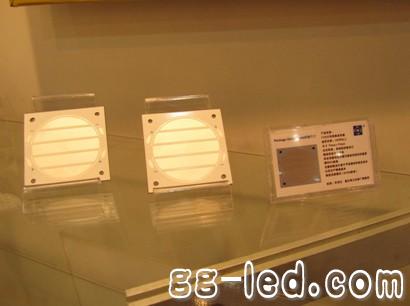[Text / high-tech LED reporter Liu Pingping] The issue of heat dissipation has always been the focus of LED companies' continuous attention. The heat dissipation capability of LED lighting products directly affects the actual luminous efficiency and lifetime of LEDs. Since too many active heat dissipation mechanisms cannot be used, the requirements for heat dissipation efficiency are more manifested in the passive heat dissipation mode.
At present, the mainstream heat sink substrates on the market are still aluminum substrates and copper substrates, and some manufacturers are committed to the research and development and production of ceramic substrates. In addition, a new package substrate developed by AlSiC composite material between aluminum and ceramic is also about to be introduced to the market.
Xi'an Mingke Microelectronics Materials Co., Ltd. (hereinafter referred to as “Xi'an Mingkeâ€) was unveiled with the AlSiC composite packaging substrate at the 2013 Hi-Tech LED Lighting Exhibition held on November 25-27.
Ma Junli, Chairman of Xi'an Mingke, introduced that AlSiC composite materials fully combine the different advantages of silicon carbide ceramics and metal aluminum, with high thermal conductivity, thermal expansion coefficient matched with chip, low density, light weight, high hardness and high bending strength. And so on, is the leader in the new generation of electronic packaging materials.
"It has a higher glass transition temperature. The glass temperature of general metal materials is 225 ° C, but this material can reach 400 ° C." Xi Yong Mingke technical director Wang Yong told reporters that AlSiC composite material solves the problem that metal materials are easily deformed by heat. problem. “The same thickness deformation ability is small, basically unchanged.â€
According to Wang Yong, the packaging power density of AlSiC composites is about 40% higher than that of metal materials, which means that the same area can obtain more package power. In addition, it makes LED lamps have less light attenuation every 3000 hours. Light decay is about 1‰.
Ma Junli told reporters that it is precisely because AlSiC composite materials have many advantages that other materials can't match. It has been widely used in aviation, aerospace, high-speed rail and microwave. In order to better push the material to the civilian market and solve the problem of LED heat dissipation, Xi'an Mingke independently developed an LED package substrate made of this material.
"We mainly want to develop a new market, making the application of LED more extensive." Wang Yong said that the current application range of LED lamps is still limited, and some special lighting (such as diving lights) still can not use LED lamps. “And the new package substrate of AlSiC composite material we developed has the best comprehensive performance, which can better solve the problem of heat dissipation, which will enable LED lamps to ensure the stability of some special lighting fields.â€
At present, the mainstream heat sink substrates on the market are still aluminum substrates and copper substrates, and some manufacturers are committed to the research and development and production of ceramic substrates. In addition, a new package substrate developed by AlSiC composite material between aluminum and ceramic is also about to be introduced to the market.
Xi'an Mingke Microelectronics Materials Co., Ltd. (hereinafter referred to as “Xi'an Mingkeâ€) was unveiled with the AlSiC composite packaging substrate at the 2013 Hi-Tech LED Lighting Exhibition held on November 25-27.

Ma Junli, Chairman of Xi'an Mingke, introduced that AlSiC composite materials fully combine the different advantages of silicon carbide ceramics and metal aluminum, with high thermal conductivity, thermal expansion coefficient matched with chip, low density, light weight, high hardness and high bending strength. And so on, is the leader in the new generation of electronic packaging materials.
"It has a higher glass transition temperature. The glass temperature of general metal materials is 225 ° C, but this material can reach 400 ° C." Xi Yong Mingke technical director Wang Yong told reporters that AlSiC composite material solves the problem that metal materials are easily deformed by heat. problem. “The same thickness deformation ability is small, basically unchanged.â€
According to Wang Yong, the packaging power density of AlSiC composites is about 40% higher than that of metal materials, which means that the same area can obtain more package power. In addition, it makes LED lamps have less light attenuation every 3000 hours. Light decay is about 1‰.
Ma Junli told reporters that it is precisely because AlSiC composite materials have many advantages that other materials can't match. It has been widely used in aviation, aerospace, high-speed rail and microwave. In order to better push the material to the civilian market and solve the problem of LED heat dissipation, Xi'an Mingke independently developed an LED package substrate made of this material.
"We mainly want to develop a new market, making the application of LED more extensive." Wang Yong said that the current application range of LED lamps is still limited, and some special lighting (such as diving lights) still can not use LED lamps. “And the new package substrate of AlSiC composite material we developed has the best comprehensive performance, which can better solve the problem of heat dissipation, which will enable LED lamps to ensure the stability of some special lighting fields.â€

Mineral Insulated Cable,Copper Mineral Insulation Cable,Copper Core Copper Sheath Cable,Fire Resistant Cable
Baosheng Science&Technology Innovation Co.,Ltd , https://www.cablebaosheng.com